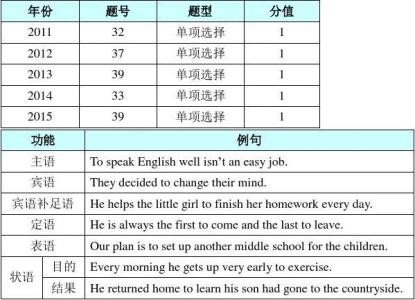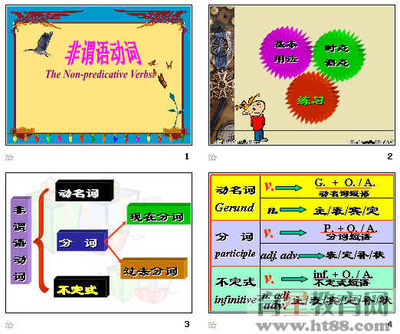初中英语谓语有哪些?
动词不定式:(to)+do,具有名词、形容词、副词的特征。
1.不定式的形式:(以动词write为例)否定式:not + (to) do
(1)一般式:不定式的一般式所表示的动作与谓语动词动作同时发生或发生在谓语动词动作之后, 例如:I'm glad to meet you.
(2)进行式:不定式的进行式所表示的动作与谓语动词动作同时发生,例如:The boy pretended to be working hard.
(3)完成式:不定式的完成式表示的动作发生在谓语动词动作之前,例如: I regretted to have told a lie.
2.不定式的句法功能:
(1)作主语:To finish the work in ten minutes is very hard.
动词不定式短语作主语时,常用it作形式主语,例如上面两句可用如下形式:It is very hard to finish the work in ten minutes.
(2)作表语:Her job is to clean the hall.
(3)作宾语:常与不定式做宾语连用的动词有:want, hope, wish, offer, fail, plan, learn, pretend, refuse, manage, help, agree, promise, prefer, 如果不定式(宾语)后面有宾语补足语,则用it作形式宾语,真正的宾语(不定式)后置,放在宾语补足语后面,例如:Marx found it important to study the situation in Russia.
动词不定式也可充当介词宾语,如:I have no choice but to stay here.
动词不定式前有时可与疑问词连用,如:He gave us some advice on how to learn English.

(4)作宾语补足语:在复合宾语中,动词不定式可充当宾语补足语,如下动词常跟这种复合宾语:want, wish, ask, tell, order, beg, permit, help, advise, persuade, allow, prepare, cause, force, call on, wait for, invite.
此外,介词有时也与这种复合宾语连用,如: With a lot of work to do, he didn't go to the cinema.
有些动词如make, let, see, watch, hear, feel, have等与不带有to的不定式连用,但改为被动语态时,不定式要加to, 如:I saw him cross the road.
(5)作定语:
动词不定式作定语,放在所修饰的名词或代词后。与所修饰名词有如下关系:
①动宾关系:I have a meeting to attend.
注意:不定式为不及物动词时,所修饰的名词如果是地点、工具等,应有必要的介词,如:He found a good house to live in.
如果不定式修饰time, place, way,可以省略介词:He has no place to live.
如果不定式所修饰名词是不定式动作承受者,不定式可用主动式也可用被动式:Have you got anything to send?
②说明所修饰名词的内容: We have made a plan to finish the work.
③被修饰名词是不定式逻辑主语:He is the first to get here.
 爱华网
爱华网



